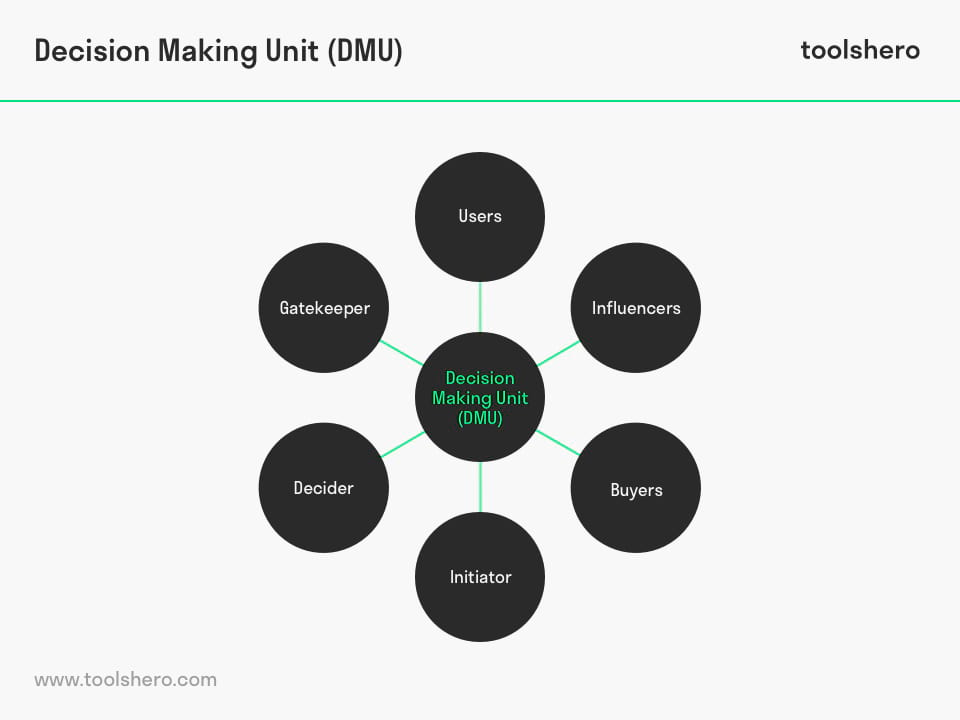Decision Making Unit (DMU) explained

Decision Making Unit (DMU): this article explains Decision Making Unit or DMU, developed by Philip Kotler in a practical way. Next to what it is, this article also highlights the collective decision makers and the three types of buying situations. After reading you will understand the basics of thismarketing and stakeholder management tool. Enjoy reading!
Introduction
In a business-to business context (purchase) decisions are made collectively.
Suppliers find it important to know who the most influential person in this process is. In literature the whole team of decision makers is known as the Decision Making Unit (DMU) or Buying Center.
Marketing guru Philip Kotler has frequently described the Decision Making Unit (DMU) in his marketing books.
What is a Decision Making Unit (DMU)?
Philip Kotler defines the decision making unit or DMU as “all individuals and groups that take part in the decision-making process relating to the negotiation of products /services”.
The DMU consists of a group of people who take collective decisions about the purchasing of goods and / or services.
Philip Kotler has defined six roles and he has indicated that it is possible for one person to have several roles:

Figure 1 – Decision Making Unit (DMU)
1. Users
These are the people who are actually going to work with the purchased goods or services and they exert influence on the specifications. Both customers and employees may take on this role.
2. Influencers
They can exert influence on the purchasing process by setting preconditions. They can be found at all levels of the organization.
3. Buyers
The buyer is the actual negotiator with the supplier. The buyer negotiates about contract terms and eventually places the order. The buyer takes up one of the most important roles within the DMU.
4. Initiators
The initiator is the player who recognizes a problem and tries to find a solution for this problem. This is the most important person in the DMU.
5. Deciders
The Decider is the player who is ultimately responsible for choosing the supplier and as a result takes up an important position within the DMU or Strategic Business Unit.
6. Gatekeepers
The Gatekeeper is responsible for the information provision within the decision making unit or DMU. The Gatekeeper determines the type of information that will be delivered to a certain player and as a consequence they can influence the decision making process strongly.
Decision Making Unit (DMU): Three types of buying situations
Not every decision requires the involvement of all the roles. Simple decisions, such as the purchasing of stationery, require fewer roles in the decision making process than the purchase of production machinery or a new IT system.
In addition three types of buying situations can be distinguished:
1. Straight rebuy
This involves a routine repurchase. The goods and/or services have been bought before from an established supplier.
2. Modified rebuy and the position of the Decision Making Unit
One or two components are new in this purchase process; a new product and / or service or a new supplier. If the complexity is low, there will no new DMU is required. A new DMU may be created when the rebuy is more complex.
3. New buy and the position of the Decision Making Unit
Both the products / services and the supplier are new. This will automatically require a new decision making unit.
Decision Making Unit (DMU) is changing all the time
A DMU is rarely stable and it often changes. The DMU may change as a result of the addition of another person.
Conflicts of interest may also play a major role as a consequence of which the outcome of the decision making process becomes unpredictable. It is advisable to look at the influence, perception, roles and risks from a distance.
It’s Your Turn
What do you think? How do you manage your Decision Making Units? Do you recognize the practical explanation or do you have more suggestions? What are your success factors for the good stakeholder management?
Share your experience and knowledge in the comments box below.
More information
- Charnes, A., Cooper, W. W. & Rhodes, E. (1978). Measuring the efficiency of decision making units. European journal of operational research (EJOR), 2(6), 429-444.
- Kotler, P. (1965). Competitive strategies for new product marketing over the life cycle. Management Science, 12(4), B-104.
- Kotler, P. & Armstrong, G. (2010). Principles of marketing. Pearson education.
- Pollay, R. W. (1968). A model of family decision making. European Journal of Marketing, 2(3), 206-216.
How to cite this article:
Van Vliet, V. (2011). Decision Making Unit (DMU). Retrieved [insert date] from Toolshero: https://www.toolshero.com/marketing/decision-making-unit-dmu/
Original publication date: 02/08/2011 | Last update: 11/13/2023
Add a link to this page on your website:
<a href=”https://www.toolshero.com/marketing/decision-making-unit-dmu/”>Toolshero: Decision Making Unit (DMU)</a>













One response to “Decision Making Unit (DMU) explained”
Cool, the decision making unit is like the number of votes a person have (in differents roles) related to a question?